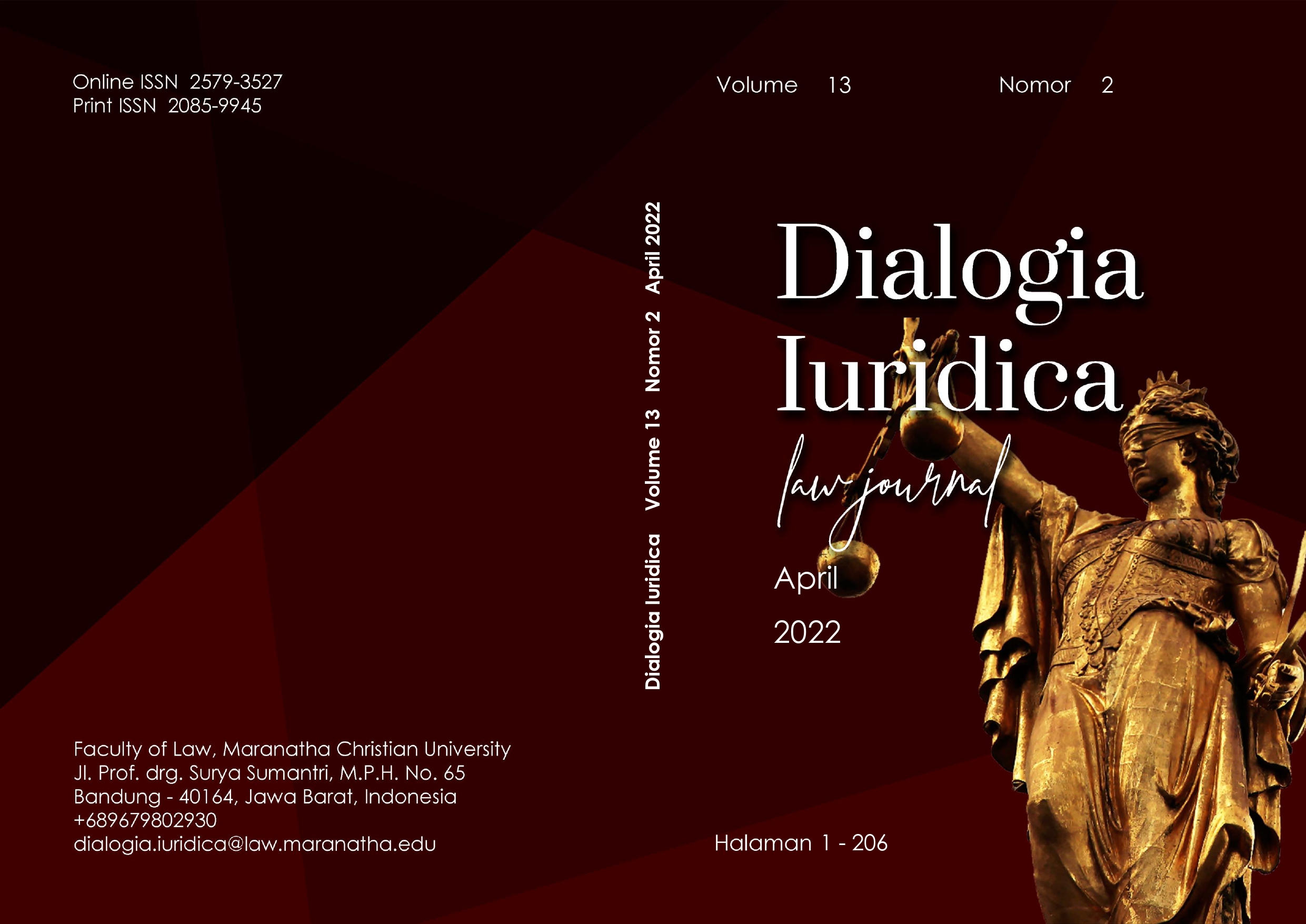Tinjauan Konsep Hak Eksklusif dalam Hak Cipta Berdasarkan Teori Hegel
DOI:
https://doi.org/10.28932/di.v13i2.4577Kata Kunci:
Hegel, Copyright, Moral RightsAbstrak
Copyright is a protection in a form of an exclusive right which is attached with the creator, including moral rights which are possessed by the creator for the embodiment for their personality in the creation. The referred moral rights are recognized in the international treaties, specifically in Berne Convention and TRIPS Agreement, which put forward the moral rights as a copyright protection. The protection of moral rights evolved from the Continental Europe countries, which recognizes author’s rights. The principle of moral rights could be analyzed with Hegel’s theory from the writing in his book entitled “Philosophy of Rights”, postulating the principle of how a person could claim his right of property possessions. In accordance with Hegel’s theory, this research will be focused on the scope of copyright as an exclusive right, which will also analyze the copyright law of Indonesia regulated in Law Number 28/2014. The copyright protection regarding moral rights in Law Number 28/2014 principally regulates the right given to the creator to signify their identities in their creation or to claim for their creation which adheres with their personalities. Moral rights are also given to performers in the form of related rights, as a right for the performers to claim the performance of the creation.Unduhan
Referensi
Buku
Dudley Knowles, Hegel and the Philosophy of Right, London: Routledge, 2002.
G.W.F. Hegel (Diterjemahkan oleh T. M. Knox), Outlines of Philosophy of Rights, New York: Oxford University Press, 2008.
Peter Drahos, A Philosophy of Intellectual Property, Aldershot: Dartmouth Publishing Company, 1996.
Jurnal
Agus Sardjono, “Hak Cipta Bukan Hanya Copyright”, Jurnal Hukum dan Pembangunan Tahun Ke-40 Nomor 2, 2010. DOI: http://dx.doi.org/10.21143/jhp.vol40.no2.217
Donald P. Harris, “TRIPS’ Rebound: An Historical Analysis of How The TRIPS’ Agreement Can Ricochet Back Against the United States”, Northwestern Journal of International Law & Business, Vol. 25 Issue 1, 2004.
Inda Nurdahdiar, “Analisis Penerapan Prinsip Perlindungan Langsung dalam Penyelenggaraan Pencatatan Ciptaan”, Veritas et Justitia, Volume 2 Nomor 1, 2016. DOI: https://doi.org/10.25123/vej.v2i1.2073
Monika Suhayati, “Perlindungan Hukum Terhadap Hak Ekonomi Pemilik Hak Terkait dalam Undang-Undang Nomor 28 Tahun 2014 tentang Hak Cipta”, Negara Hukum, Volume 5 Nomor 2, 2014.
Renato Cristi, “Hegel on Property and Recognition, Laval Théologique et Philosophique, Vol. 51 No. 2, 1995. DOI: 10.7202/400918ar
Stig Stromholm, “Droit Moral - The International and Comparative Scene from A Scandinavian Viewpoint”, Scandinavian Studies in Law, No. 42, 2002.
Walid Abdelgawad, “TRIPS Agreement: From Minimum Standards to Double Standards of Intellectual Property Rights Protection in North-South Relations”, HAL, 2015.
William Strauss, “The Moral Right of The Author”, The American Journal of Comparative Law”, Vol.4 No. 4, 1955. DOI: https://doi.org/10.2307/838072
Peraturan Perundang-Undangan
Undang-Undang Nomor 28 Tahun 2014 tentang Hak Cipta.
Dokumen Internasional
Berne Convention for The Protection of Literary and Artistic Works (1979).
The Agreement on Trade-Related Aspects of Intellectual Property Rights (1995).
European Parliamentary Research Service, “Copyright Law in The EU: Salient Features of Copyright Law Across The EU Member States”, Comparative Law Library Unit, 2018.
World Intellectual Property Organization, WIPO Intellectual Property Handbook, Jenewa: WIPO Publication, 2004.
World Intellectual Property Organization, Understanding Copyright and Related Rights, Jenewa: WIPO Publication, 2016.
Pranala Luar
Copyright House, “Berne Convention”, https://copyrighthouse.org/countries-berne-convention/, diakses 3 Januari 2022.
Direktorat Jenderal Kekayaan Intelektual, “Sejarah DJKI”, https://dgip.go.id/tentang-djki/sejarah-djki#:~:text=Secara%20historis%2C%20peraturan%20perundang%2Dundangan,UU%20Hak%20Cipta%20(1912), diakses 7 Januari 2022.
United Nations Treaty Collections, “No. 11850 Multilateral Berne Convention for the Protection of Literary and Artistic Works”, https://treaties.un.org/doc/Publication/UNTS/Volume%20828/volume-828-I-11850-English.pdf, diakses 28 Februari 2022.
World Intellectual Property Organization, “Berne Convention”, https://www.wipo.int/edocs/lexdocs/treaties/en/berne/trt_berne_001en.pdf, diakses 28 Februari 2022.
World Trade Organization, “Introduction to the TRIPS Agreement”, https://www.wto.org/english/tratop_e/trips_e/ta_docs_e/modules1_e.pdf, diakses 3 Januari 2022.
World Trade Organization, “Principles of The Trading System” https://www.wto.org/english/thewto_e/whatis_e/tif_e/fact2_e.htm, diakses 4 Januari 2022.
World Trade Organization, “Overview: The TRIPS Agreement”, https://www.wto.org/english/tratop_e/trips_e/intel2_e.htm, diakses 4 Januari 2022.
World Trade Organization, The Agreement on Trade-Related Aspects of Intellectual Property Rights, https://www.wto.org/english/docs_e/legal_e/27-trips.pdf, diakses 28 Februari 2022.
##submission.downloads##
Diterbitkan
Cara Mengutip
Terbitan
Bagian
Lisensi
Hak Cipta (c) 2022 Anastasia Theresia Puspasari

Artikel ini berlisensi Creative Commons Attribution 4.0 International License.













